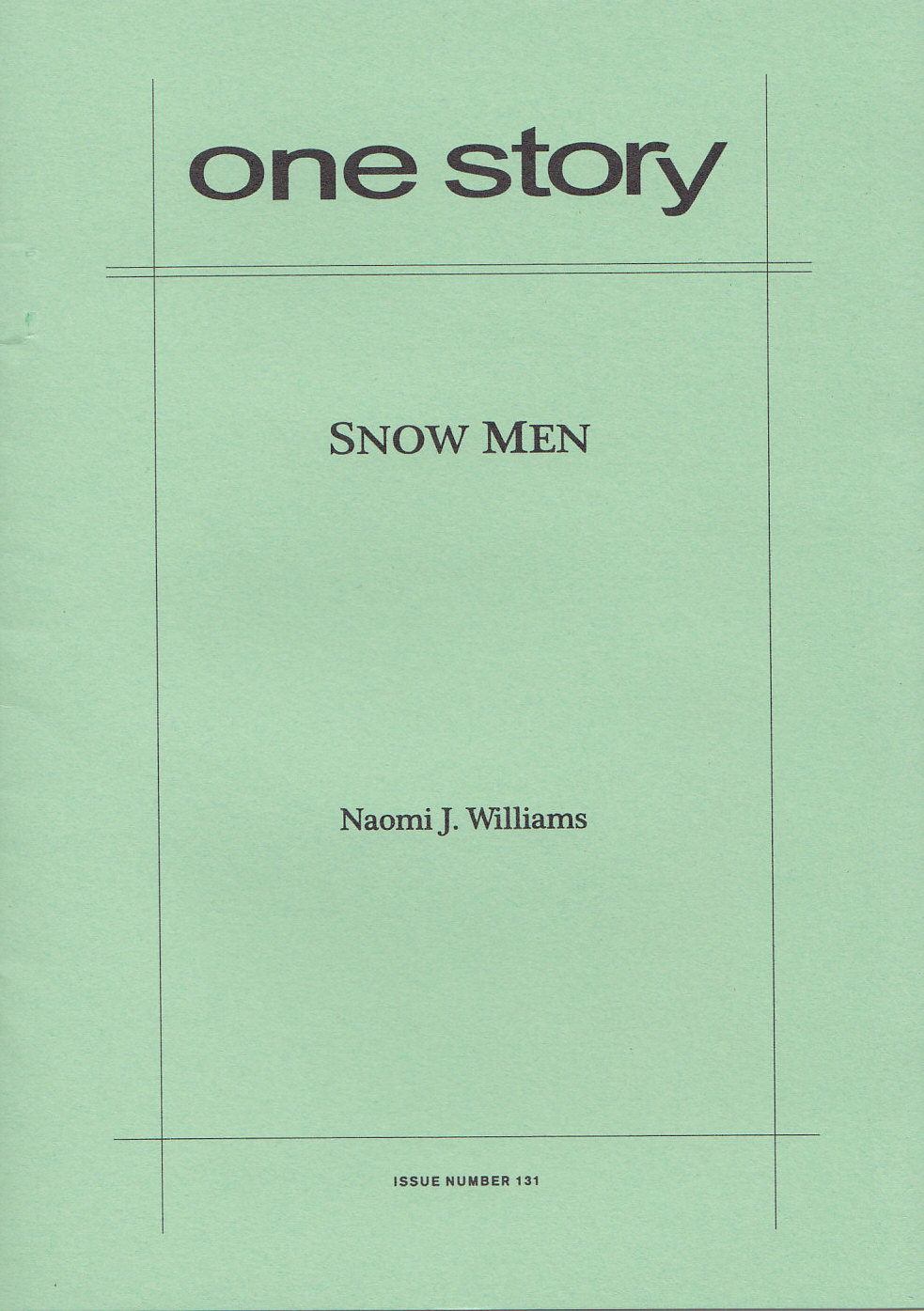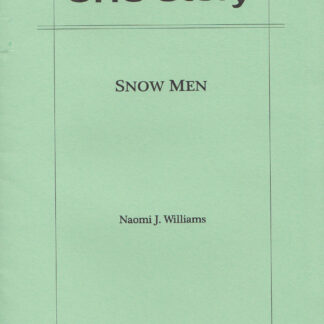
Snow Men
$2.50
42 in stock
Excerpt
Lituya Bay, Alaska – July 1786
There is a big disagreement in my family about what happens if you drown and your body is never found. My aunts say that you are turned into one of the Land Otters. The Land Otters come up out of the water, in the dark, and steal away the living. You cannot see them, but sometimes you can hear them—they whistle. We lie in our huts at night and listen for whistling, because we lost a canoe when we arrived for the salmon season, and afterward we found only four of the bodies.
My father and his brothers say it is true about the Land Otters everywhere else, but not here. Here, they say, if you drown you are turned into a bear and become a lookout for Kah Lituya. Kah Lituya is the jealous spirit of this place. He sleeps at the mouth of the bay and tries to capsize canoes when they pass. He turns the people who drown into bears and makes the bears watch for more canoes coming into the bay. The aunts say they know about Kah Lituya, they respect his jealousy, they just do not agree about him turning people into bears.
Naomi Williams
Naomi J. Williams recently completed an M.A. in creative writing from the University of California, Davis. Her stories have appeared in A Public Space, American Short Fiction, The Colorado Review, Gettysburg Review, The Southern Review, and ZYZZYVA, and she is a recipient of a 2009 Pushcart Prize. “Snow Men” is part of an in-progress collection of linked short stories about the 18th-century La Pérouse expedition. Naomi lives in Davis, California with her family, and works as an adjunct professor of English at Sacramento City College.
Q&A by Elliott Holt
- EH: Where did the idea for this story come from?
- NW: Almost as soon as I decided to write a collection of stories about the La Pérouse expedition, I knew I wanted to set a story in Lituya Bay. Everything had gone so well for the expedition until they got to Alaska, and then this freakish accident occurred that carried off 10% of the crew in one morning. I also knew I wanted some of the stories told from a non-male, non-mariner, non-western point of view. I’d read the work of George T. Emmons, an ethnographer who’d gathered oral histories among the Tlingit people of southeast Alaska in the early 20th century. Turns out the Tlingit had been handing down for 200 years the story of the La Pérouse expedition’s arrival in Lituya Bay and their misadventures there. It included wonderful details that you won’t find in the French accounts of the voyage (like calling the white men “Snow Men”). So I decided to retell this episode from the point of view of a native girl who witnesses the Frenchmen’s arrival and then the accident.
- EH: This story is part of a series of linked stories about the 18th-century La Pérouse expedition. What prompted your interest in that event? What sort of research did you do?
- NW: About 10 years ago my husband bought me an antique map for my birthday. The map dealer said it was an 18th-century map of San Francisco, but it wasn’t: it was a map of Lituya Bay, and it was from the first English-language edition of La Pérouse’s journals. I looked up La Pérouse on Google and pretty quickly became obsessed with the story of the expedition. So what started as a little research about the origins of my map turned into this life-consuming project. I just love research. In many ways, the writing is just an excuse to go to the library and look stuff up. Once I’d exhausted all the English-language sources on the expedition, I studied French so I could read sources in the original and do a little research in France. What’s both fun and maddening about this project is that every story is set in a different place, so the research requirements are monumental. For this piece, for instance, I read everything I could about Tlingit history, culture, and mythology, and spent a lot of time examining photos of Lituya Bay, researching the flora and fauna of the area, and staring at my old map. But for other stories I’ve pored over genealogical records, stage plays, Napoleonic decrees, and scholarship about everything from colonial Chilean cuisine to beliefs about suicide in the South Pacific.
- EH: One of the challenges of writing linked stories is making sure that each story can stand on its own, without the context of the full collection. How do you balance the needs of each story with the needs of your book as a whole?
- NW: You’re right that it’s a challenge, although there’s something inherently episodic about a voyage that lends itself to this treatment, I think. I occasionally try to sneak something in that’s going to resonate with another story in the collection. Sometimes it slips by unnoticed; more often, one of my trusted readers or an editor will flag it as not quite working, and I’ll think, “Damn! Busted again.” But usually, for the time that I’m working on an individual story, I try to isolate in my mind the incident in question or the character I’m focused on and “pretend” that’s the only story I have to tell.
- EH: Are the other stories in the collection narrated by the same character?
- NW: No. Each story has a different point of view. The girl who narrates “Snow Men” does appear briefly in another story, which relates the same events but from one of the French captains’ point of view. He’s the man she meets out on the spit when she wanders away from the village. It’s the only place in the collection where I relate the same events from two different vantage points.
- EH: What was the most challenging aspect of writing this story?
- NW: The biggest challenge was pinning down the narrator’s voice. I wanted to make sure she didn’t sound like a 21st-century American teenager transplanted to a pre-contact village in southeast Alaska. In the earliest drafts, she spoke in this mysterious, non-linear way with lots of incomplete sentences and no tense. With the help of some blunt feedback from my thesis committee at UC Davis, I was persuaded to jettison this approach and write the story in a more accessible way. And additional research (see, I’m never far from the library!) revealed that her language was probably a highly inflected one, so the notion that she would somehow speak without clear syntax or reference to time was, in addition to being really cumbersome on the page, ahistorical.
- EH: The narrator of your story is a girl in a community that gives much more credit to men. She is braver than the boys, but is consistently underestimated. How conscious were you of exploring gender conflicts while writing?
- NW: Well, it’s not like I sat down and said, Here’s a good gender-conflict story. But I’m pretty much a card-carrying feminist, so it’d be disingenuous to claim I didn’t know what I was doing. Having said that, though, I think part of the impetus for this character was that I needed to have a narrator who was a little isolated from her community, maybe even at odds with her community. That isolation made for a good observer, I thought. I will confess to having something of an agenda for the project as a whole, which is to expand the parameters of “nautical” fiction. Most such fiction is told exclusively from the white, male mariner’s point of view—often from the flawed-but-brilliant captain’s point of view. I love a lot of this fiction—I’ve read and re-read Patrick O’Brian’s Aubrey/Maturin novels and I also love Forester’s Horatio Hornblower books. But in my work, I want to include the experiences of other people associated with a voyage like this one—the other men on board, the people they encounter on shore, the families waiting for them at home, etc.
- EH: Your narrator becomes familiar with loss, love (the beginnings of it, anyway) and of course, with the very different culture of the white men she encounters. But her relationship with her young cousin seems to be the heart of the story. His illness reminds us, as readers, of how fragile everything is in this world. We can’t help but wonder if the narrator is destined to experience another loss. Her cousin’s illness isn’t explained—is it tuberculosis?
- NW: Yes, I’d assumed from the beginning that he had TB, and I honestly don’t know whether or not he survives long enough to marry her. I’m glad you see the narrator’s relationship to him as central to the story, because as exciting and unnerving as the appearance of these white people would have been, these Snow Men are going to leave in two weeks, and the narrator’s life, with this sickly boy as her intended and her nagging aunts and the not-so-brave brothers, will go on in this place. And although more and more white explorers and fur-traders will show up in the years to follow, it’s certainly possible this character will never see another white man in her life. In many “first contact” narratives, there are indigenous people living peaceably (or not, as the case may be), and then white people show up and ruin their lives. And while that certainly happened, I wanted to get past the native-as-victim-of-white-aggression story and write about lives that endure. For 200 years, these people told their children and grandchildren the story of two ships full of “Snow Men” coming to Lituya Bay and how a bunch of them had drowned in a freak tidal current. So it was a momentous event, but in this particular instance, more fateful for the explorers than for the natives, whose communities and traditions survived for a long time thereafter.
- EH: How long did it take you to complete this story?
- NW: I first drafted the story in 2005, and continued to tweak it till you guys sent it to the printer! I’m an exceedingly slow writer. I’ve calculated that at my current rate of production, I’ll be well into my dotage before the collection is complete.
- EH: What are you working on now?
- NW: Oh, I’m still slogging away at this collection. Right now I’m revising the companion story to “Snow Men,” which I alluded to earlier. I’m also drafting what I hope will be the first story in the collection, which takes place in London right before the expedition leaves France. So I’m up to my ears in Georgian architecture and British purveyors of navigational instruments and catalogs of English watercolors. It’s great fun.
- EH: What is the best bit of advice about writing you have ever received?
- NW: I’ve had many wonderful writing teachers and I’m grateful to all of them, but Yiyun Li said something in a writing class that I’ll never forget: “Your character’s problems should never be the story’s problems.” A confused character doesn’t excuse a confusing narrative, a bored character isn’t allowed a boring story, and so on. Words to write by.
